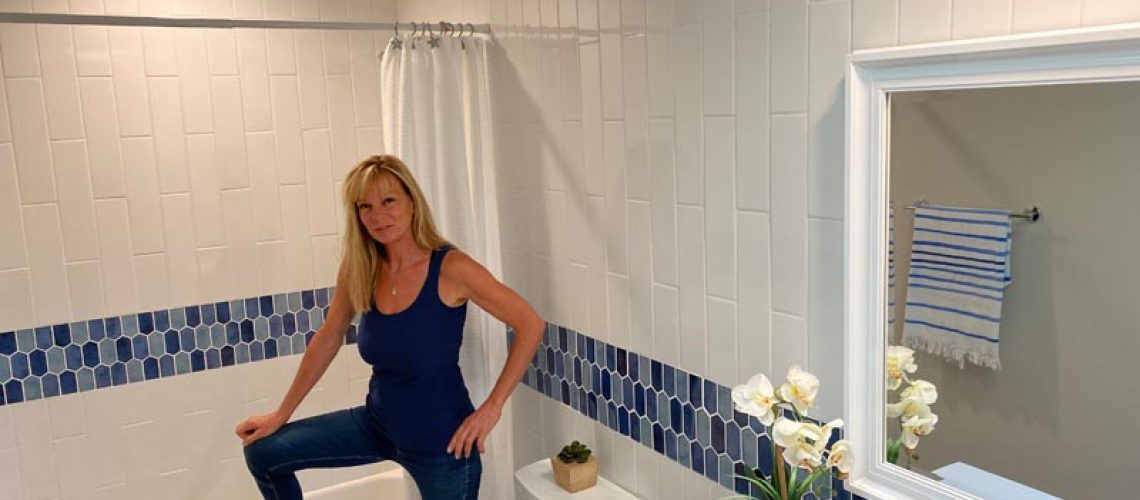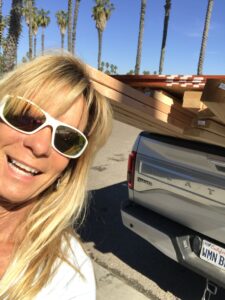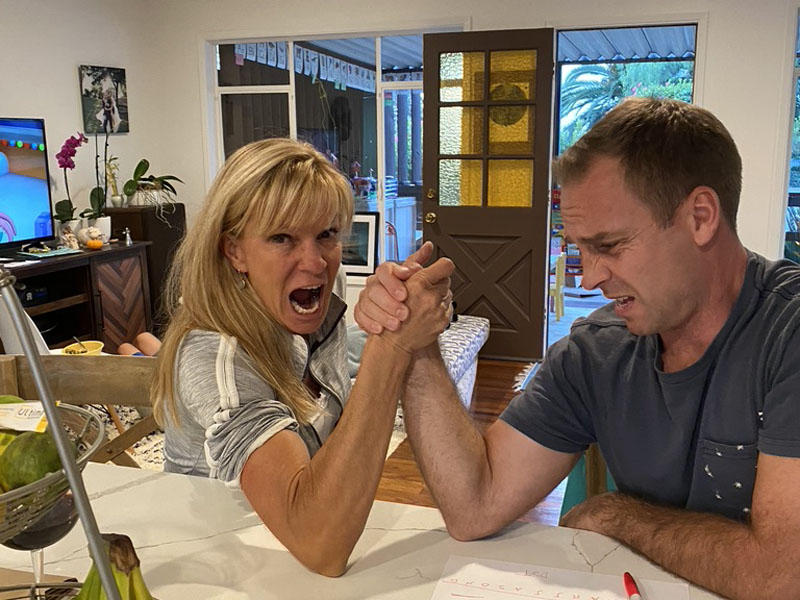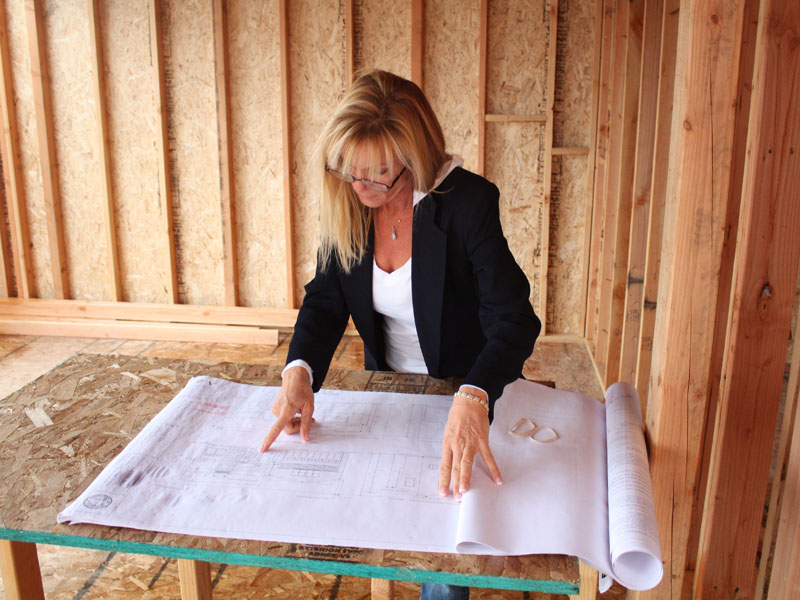Are you sick and tired of your bathroom?
Does any of this ring a bell:
- Ugly chipped pink tile, reminiscent of the ‘50s
- The shower looks to have mold, but you can’t tell the difference between the dirty grout and a real mold issue.
- The sink has a big crack.
- The toilet rocks when you sit on it.
- The vanity door hinges, which have been painted 20 times, are just about to fall off.
Sound familiar?
Let me share with you what you can do about it right now!
Three Things You Can DIY
1
Demo
Short for ‘demolition’, this is a fun and easy thing to do to save a home remodeler bucks. Get your safety glasses on, grab your sledgehammer, and go!
Find the Water
First find your water shutoff. It’s a valve next to one of the hose bibs in the front of the house somewhere. It usually has either a round handle (if your house is ancient), or a lever if newer. At this point you don’t need to turn off any water, just be aware of its location in case you need to.
Vanity Be Gone
Next remove the vanity. Shut off your water valves under the sink. The off position is usually clockwise. Test the water to make sure it’s off. Next unscrew the hoses from the pipes in your wall. You may need pliers but be gentle here; sometimes they may break if old. Remove the countertop by pulling up. If it’s tile you may have to use a sledgehammer. Make sure you have safety glasses on and pound away. Now you can unscrew the vanity from the wall and carry it out.
Toilet Liftoff
The toilet needs to come off next. Flush it, and when the water is at the low point turn the angle-stop clockwise to shut off the water. Unscrew the bolts and lift the toilet off! Some water may leak out but if you place it in a black trash bag, any excess will be captured. Note some toilets are two-piece and will need to be taken off one part at a time.
Mirrors Away!
Mirrors are easy but be careful of breaking them and hurting yourself. Safety glasses are a must as well as gloves. If the mirror is already cracked use duct tape to tape the broken areas so it doesn’t shatter. Carefully remove from the wall.
Get On the Tile
The shower or tub is the most effort and sweat time. Perhaps you have a plastic or one piece shower; in that case it’s easy to disconnect the shower head and pull it off the wall.
Tile is a bear. Just remember that each chisel and hammer exertion will be an opportunity to save money. Most guys charge a handsome bit for doing this. It’s dusty, dirty and you need some gumption.
After removing all of the tile down to the wood or studs you can clean up. A shop vac does an amazing cleanup of all the dust and debris.
Now you are all set to get the experts in to take a look at the pipes and walls.
2
Paint
Second item you can DIY is paint. Painting is fun and easy and will save you money if you do it yourself.
Once your bathroom is drywalled and textured, with the new shower and tile installed, it’s time to prime the walls. Go to your hardware store and purchase a great primer (I like KILZ brand, however there are many brands to pick from).
Next select your bathroom color from a near-unlimited hue selection. Keep it light and bright.
Once you have selected a color make sure it has a sheen, usually eggshell or semi gloss, depending on the manufacturer of the paint. This helps seal the walls from moisture that builds up in the bathroom from showers. This seems so obvious to me over the 30 years of building but is always worth noting for a newbie DIYer.
3
Go Shopping
You can choose the vanity and tile, plumbing fixtures including, sink, faucet, shower valve and trim kit.
Keep in mind:
- The toilet center of the sewer pipe to the wall should be 15”. That means on the opposite side you’ll need to maintain 15” minimum as well. Often next to the toilet is the vanity. Now you can properly size your vanity so that it is not too close to the toilet. Most common off the shelf sizes of vanities are 24, 36”and 48”. There are some amazing fun vanities online, many exciting colors and shapes, very easy to order and get delivered.
- For the plumbing fixtures, toilet and sink, familiarize yourself with online options. HOUZZ has great ideas. Home Depot, Lowes and Build.com are excellent sources for the fixtures as well as finishes.
- A Hint: Purchase fixtures like Moen and Kohler for less issues down the road. The brands that are produced specifically for Home Depot and Lowes often will have a shorter lifespan and break easier. That is my experience and opinion of course and there are exceptions but not many.
- Don’t necessarily buy the cheapest fixtures, they are costly to replace especially shower valves because they are behind your tile wall!
Tile is fun and plentiful with online shopping both at the big box stores and very specialized boutique shops (of course you’ll pay more here). Talk with your tile person for quantities. Look through online sites like HOUZZ, Pinterest, and HGTV for ideas and patterns.
In the end keep it simple because the more detail with multiple tiles and patterns the pricier the labor.
Three Things You Should Never DIY
1
Plumbing
Don’t do the plumbing yourself.
It doesn’t pay off, no matter how many YouTube videos you watch.
DIY plumbing is a water leak waiting to happen… and water always leaks when you’re not home!
Water damage causes a boatload of peripheral expenses, insurance claims and heartache.
Pay for the licensed and insured plumber. It’s the only way to go. It is worth the headache and the liability to have an expert at your fingertips with all things water and sewer.
2
Electrical
I remember a time when I got a shock from an electrical cord. It threw me across the room and dazed me for a bit. Not something you should ever repeat; it was really no fun and scared me half to death.
Electric subcontractors with both a license and insurance are worth their weight in gold.
He/she holds a specialized electrical license and will install your can lights, GFIs (ground fault interrupters) and your bathroom exhaust fan. GFIs are made to be a fast-acting circuit breaker and will shut off the power within 1/40th of a second if overload. This is building code. You certainly don’t want a fire from a homeowner’s first-time wiring experience. This is a very costly and devastating mistake.
3
Waterproofing and Tile
The third and final item to never do yourself is waterproofing and tile.
(Although I must note a caveat here. Many homeowners have tiled their own showers with great success, but as a first time bath remodeler you may want to watch an expert the initial time through. This can be learned online if you have the confidence with a tile saw, cement mud and some great trowels and straightedge.)
Waterproofing is not for beginners.
It is the critical piece to the entire shower to do correctly. There are tar-like materials called hot-mop. This thick and hot black material is coated heavily on the appropriately-sloped shower pan, and up over the dam that was framed in lumber. It must be sloped towards the new drain and must be water tested after it is dry. You must be careful to not drop a nail or screw to puncture the material once dried.
The other option is the heavy plastic liner. This liner can be bought at any box hardware store. It must be followed to the tee in order to be fully waterproof in your shower pan. Both of these must be code compliant and thus require a building permit.
As with all remodel projects, before you start, check with your local building department to see what requires a building permit.
In Summary...
Remodeling is a complete blast.
Yes I said that! It really is with the right attitude.
The transition from old and nasty to fresh new and cheerful is beyond words.
Your new bath is your very own expression of color and style.
It is eye-opening how much a small bath remodel can change a house and how you feel in it.
Demo, painting, and shopping for your materials is a fun way to curb costs during a bath remodel. These you can definitely DIY.
Plumbing, electrical, tile, and waterproofing are best to never do yourself. (With the slight exception of the tile. ) These items make your life a lot more enjoyable when you hire licensed and insured people to do what they do best – making sure you’re safe and up to current building codes and standards.
Happy Renovating,





